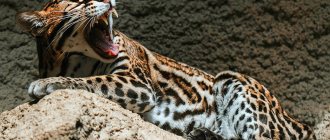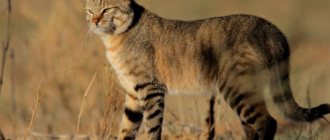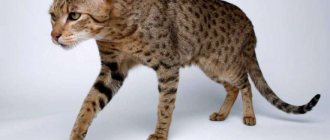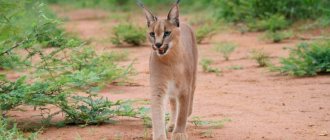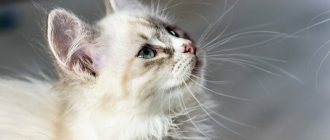The steppe cat or wild cat Felis libyca is not just the progenitor species of all modern cat breeds, but also the first domesticated feline species.
Today, due to many factors, the id is rare, but still found in the wild. The species of wild steppe cat emerged as an independent species 130,000 years ago. Domestication began to occur 10,000 years ago in the Middle East,
where cats had a great influence on religion, culture and human life. Agree, a cat is of little use. Catching mice and no loyalty.
History of the discovery of the species
More than ten thousand years ago, humanity reached a stage of development when the foundations of land use began to emerge and the first stable human settlements appeared. Man moved from a nomadic lifestyle in caves to creating dwellings with his own hands.
It is believed that it was then that, along with ungulates and canines, Steppe cats were also domesticated. The man quickly realized the benefits of friendship with this predator.
Of course, you can’t plow on a cat like a mule, or use it in hunting like a dog, but the cat can cope with hordes of rodents that destroy food supplies.
Now the Steppe cat is often found near human settlements, especially in winter, because at this time the food supply in its natural habitat is scarce, and there are always a lot of rats and mice near people’s homes, which also strive to survive there.
There was never any persecution of this animal, nor was there any special hunting - the animal’s fur is not considered valuable, but the number of some subspecies has greatly decreased due to human activities in the development of new lands.
As the latest research by scientists has shown, the first to domesticate the cat were probably not the ancient Egyptians, but the peoples from the “cradle of civilization” - the place where humans first settled. Now here are modern Iraq, Syria, Lebanon, Israel. From there, cats found their way to Ancient Egypt, and then spread throughout the world through smuggling (Phoenicians and Greeks) and purchasing for fabulous sums (Europe and Russia).
Nutrition
The main activity of the steppe cat is hunting, which it does very well, as it has all the necessary tools for this. Sharp claws that are hidden in the paw pads, long fangs that can dig into the integument of the prey, and a rough tongue with horny growths that allow you to lick the bones of prey white. The main food is small animals, namely:
- mice;
- rats;
- gophers;
- jerboas;
- steppe turtles.
Thanks to its claws, the predator is excellent at climbing trees, where it can steal a nest with bird eggs or chicks. Turtle eggs are also a pleasant prey, the location of which the cats determine by smell, after which they dig them out of the ground and eat them. Spotted cats do not disdain fish, which they catch in nearby reservoirs, running lizards and some insects, for example, locusts or dragonflies. This animal is not large, so small prey is more than enough for it. Cats do not hide the food they catch in reserve; they eat everything they need, and the next day they go hunting again. Before each outing, the steppe resident carefully licks himself to wash away all odors and be inconspicuous for the future dinner.
Mr. Cat explains: who is the Steppe Cat and what subspecies he has
To figure out who the Steppe Cat is, we need to consider the entire species of Felis Silvestris, which in Russian is called Forest, and in English simply Wildcat. This scientific name was given to the species in 1777 by Johann von Schreber, when he first described the European forest cat based on the work of earlier naturalists such as Mathurin Brisson, Ulysses Aldrovandi and Conrad Gessner.
In the 1940s, taxonomist Reginald Innes Pocock examined a collection of skins and skulls of these predators at the Natural History Museum in London and identified subspecies of forest and steppe cats. Hence, all subspecies of Felis Silvestris are conditionally divided into two large groups, namely European forest cats (silvestris) and steppe cats (libyca), which in turn can also be conditionally divided into their own subspecies. More details below.
Silvestris group (forest cats):
- F. s. caucasica (Satunin, 1905) or Caucasian forest cat. Lives in the forests of the Greater and Lesser Caucasus. With the exception of the countries of the former USSR in Turkey (Asia Minor).
- F. s. grampia (Miller, 1907) or Scottish forest cat. As the name implies, it lives in Scotland, in its northern part.
- F. s. silvestris (Schreber, 1777) or Central European forest cat. It lives throughout Europe, but is fragmented, with the exception of Scotland, the Mediterranean islands, and Holland. Also extinct in Austria, but now found there as well due to spread from Italy to the north.
Transitional group silvestris-libyca:
Why transitional? The fact is that previously these subspecies were considered as part of libyca, i.e. steppe cats, and now as part of silvestris, i.e. forest
- F. s. cretensis (Haltenorth, 1953) or Cretan wild cat. Lives exclusively on the island of Crete. The subspecies was considered extinct, but an expedition from the Italian University of Perugia in 1996 managed to catch one individual, which was subsequently released into the wild with a radio transmitter. Later, a nest with kittens was found in the Rouvas forest.
- F. s. jordansi (Schwarz, 1930) or Balearic wild cat. It lives on the Balearic Islands, previously it was believed that on all of them, but now only on Mallorca.
- F. s. reyi (Lavauden, 1929) or Corsican wild cat. Lives on the island of Corsica.
Previously, this entire group was called F. s. sarda (Lataste, 1885). Moreover, at different times only cats living in Sardinia had this name, then in Sardinia and Sicily, and after that all 4: cretensis, jordansi, reyi and sarda.
The libyca group (i.e. the steppe cats themselves), they are further divided into two: ornata-caudata and ornata-libyca.
- ornata-caudata (steppe cats) differs from forest cats in their smaller size, lighter fur color and longer and thinner tails. The domestic cat is thought to have evolved from this group.
- F. s. caudata (Gray, 1874) or Turkestan steppe cat. It lives in Central Asia, Kazakhstan, Eastern Transcaucasia, northern Iran and Afghanistan, southwestern Mongolia and northwestern China. Since the end of the last century it has also been found in Russia.
- F. s. gordoni (Harrison, 1968) or Omani wild cat. Lives on the Arabian Peninsula, Oman and the northeastern part of the UAE. Very small, they easily interbreed with ordinary domestic cats, which leads to the extinction of the subspecies.
- F. s. iraki (Cheesman, 1921). Lives in Kuwait and Sheikh Saad on the Tigris River, Iraq.
- F. s. nesterovi (Birula, 1916). Approximate habitats: Mesopotamia and southern Iran, borders unknown.
- F. s. ornata (Gray, 1832) or Asian steppe (desert) cat. It lives throughout Pakistan, in the western and central parts of India south of the Ganges.
- F. s. tristrami (Pocock, 1944). Lives in Palestine, as well as in the west and south of Arabia.
- ornata-libyca (damn cats). It is distinguished by lighter fur, well-developed dot patterns and stripes.
- F. s. foxi (Pocock, 1944). It lives in western Africa (Paniam plateau, Bauchi province, northern Nigeria).
- F. s. haussa (Thomas and Hinton, 1921). Lives in the Sahara (Chad, Niger, Nigeria, western Sudan (Darfur deserts).
- F. s. cafra (Desmarest, 1822) or South African wild cat. It is found, as the name suggests, in southern Africa.
- F. s. griselda (Thomas, 1926). Habitat: southern Angola, Namibia, Botswana.
- F. s. mellandi (Schwann, 1904). Lives in Central Africa.
F. s. griselda F. s. mellandi
- F. s. rubida (Schwann, 1904). Lives in Congo.
- F. s. ugandae (Schwann, 1904). It lives in the south of Sudan, Congo, Uganda, Kenya, and Lake Tanganyika.
- F. s. lybica (Forster, 1780) or African steppe cat. Lives in semi-desert regions of northern Africa.
- F. s. ocreata (Gmelin, 1791). Lives in Ethiopia.
Thus, there are 15 subspecies of Steppe cats.
However, now a simplified system is increasingly used, where not groups are considered, but simply subspecies (ornata-caudata is mixed with ornata-libyca):
- F.. s. lybica - African. The species and nominate subspecies have pale, whitish or light grayish fur tinged with red on the spinal stripe, and its pointed tail is about two-thirds the length of the head to the size of the body.
- F. s. cafra - South African. Slightly different in color and pattern from the nominate species. In existing zoological specimens, the skulls are slightly longer than in northern African specimens.
- F. s. ornata - Asian. The animals have dark spots on their light, ocher-gray fur.
- F. s. silvestris - European and transitional. They have dark gray fur with distinct transverse stripes on the sides and a bushy tail with a rounded black tip.
Also often included here are Felis bieti, Chinese mountain cats.
The spotted cat is a member of a family that descended from a common ancestor about 10-15 million years ago. Felis species diverged from it about 6-7 million years ago. The European subspecies formed from 1.09 to 1.4 million years ago.
The direct ancestor of the European forest cat was Felis lunensis, which lived in Europe during the late Pliocene and Villafranchian period. Fossil remains indicate that the transformation from lunensis to silvestris was completed by the Holstein Interglacial Period 320-340 thousand years ago.
Craniological differences between the European and African cats indicate that their ancestor likely migrated during the late Pleistocene from Europe to the Middle East, resulting in a new phenotype.
Karachay-Cherkess Republic
Status: Caucasian forest cat (Felis silvestris caucasica) - III category. A rare species in the territory of Karachay-Cherkessia.
Spreading
The border of the range starts from Anapa and through mountain forests and forests of the floodplain of the Kuban and other rivers reaches the borders with the Karachay-Cherkess Republic. Within the Karachay-Cherkess Republic, these are the territories of the Zelenchuk and Urup districts, which have the most broad-leaved forests. And also from Karachaevsk up
along the valleys of the Mary and Kuban rivers with their tributaries, to level a. Upper Teberda and Elbrussky village.
It is protected on the territory of the Teberdinsky State Natural Biosphere Reserve, the Dautsky Federal Reserve, and other protected areas in the region.
Number
There is no reliable information about the number.
Source: Red Book of the Karachay-Cherkess Republic. Ed. Onipchenko V.G. (2013) Cherkessk: Nartizdat
Habitat of the Steppe cat
Steppe cats or Spotted cats are subspecies of wild forest predators that appeared about 130 thousand years ago. They range in color from brownish-sandy to grayish-yellow and have charcoal ring markers on the tail.
Small steppe predators live in the steppes, deserts, semi-deserts and mountainous regions of Africa, Western, Middle and Central Asia, Northern India, Transcaucasia and Kazakhstan. On Russian lands, the Spotted Cat is now found in semi-desert zones or floodplain shrubs in the Astrakhan and Orenburg regions, most often preferring to stay near water.
Habitats of all subspecies of Felis Silvestris (forest and steppe)
Forest wild cats differ in fur pattern, tail and size: the European has long fur and a thick tail with a rounded tip; the smaller African steppe cat is not as striped, with short sandy-gray fur and a tail that tapers to a point; Asian heavily spotted. All of them, forest and steppe cats, are slightly larger than domestic pets.
forest cat
steppe cat
The African Steppe Cat lives in a wide variety of habitats other than tropical forests, but throughout the African savannah from Mauritania on the Atlantic coast east to the Horn of Africa and altitudes of 3000 m above sea level. A small population lives in the Sahara and Nubia deserts, in the Karoo region, the Kalahari and Namib deserts. Also along the periphery of the Arabian Peninsula to the Caspian Sea, covering Mesopotamia, Israel and Palestine. Habitat in Central Asia, the range extends to Xinjiang and southern Mongolia, and in Southern Asia to the Thar Desert and arid regions of India.
Felis Silvestris is now classified as "Least Concern" on the IUCN Red List since 2002, as it is widespread and the world's populations are considered stable at over 20,000 mature individuals.
However, in some countries, Felis Silvestris is considered to be under threat from intensive hybridization with the domestic cat (F. catus) and contracting infections from it. Localized threats include being hit by vehicles and being destroyed by humans.
The rapprochement between African Steppe cats and humans appears to have evolved with the establishment of settlements during the Neolithic period, when rodents in the grain stores of early farmers attracted these predators. This eventually led to their domestication - the domestic cat is a direct descendant of the African wild steppe cat. It was one of the most revered animals in ancient Egypt.
Savannah
This breed was created artificially by crossing a serval with a domestic cat. And there is one nuance: until the fourth generation, males cannot give birth, and with each generation, the genes of the domestic cat begin to predominate more and more, so only the first generation is valued. This animal has large ears, high paws, and swims well. Savannah grows up to 60 cm in height and up to 1.3 m in length, weighing about 15 kg. Its fur is short and thick, with black spots, and its color is yellow, tan or gray.
Disadvantages of keeping a savannah at home:
- She must be walked on a leash and muzzle.
- She needs a spacious yard.
- She has a highly developed hunting instinct and can eat other domestic animals.
- If the Savannah gets into the bathtub, it will be difficult to get her out of there, not only because of the weight, but also because she will not want to get out, since she loves to swim.
- The male will mark the room, and the smell will remain the same.
- You won't be able to go on vacation or take a day off - the savannah doesn't tolerate strangers.
- If you take a couple of Savannahs in hopes of breeding, it may not work out. In addition to male infertility, there is also this problem: a couple must live together for a very long time before they want to reproduce.
- Savannah sheds heavily.
- Does not tolerate cold well.
- Savannah should be fed raw meat, vegetables and fruits.
- The price of a first-generation Savannah is about 20 thousand US dollars.
https://youtube.com/watch?v=uoLPup3sRCE
Appearance, description
The Steppe Wildcat has pointed ears, medium length and wide at the base. Vibrissae are white, from 7 to 16 on each side and reach 5-8 cm in length on the muzzle. Hairs are also present on the inner surface of the paw and measure 3-4 cm. The eyes are large, with vertical pupils and a yellowish-green iris.
Males measure 43-91 cm from head to rump, 23-40 cm tail length and usually weigh 5-8 kg. Females are slightly smaller, 40-77 cm long, weighing 3-5 kg.
Both sexes have two breast and two abdominal nipples, the preanal glands consisting of sweat and sebaceous glands around the anus. Large sebaceous and scent glands run along the entire length of the tail on the dorsal side. Males have preanal pouches on their tail that are activated upon reaching sexual maturity, which plays a significant role in reproduction and territorial marking.
Saratov region
Status: Steppe cat (Felis silvestris lybica) - category IV. A very rare, small, poorly studied species, the population dynamics of which are unknown.
Spreading
Since the mid-1990s. In different areas of the Saratov Trans-Volga region, sightings of the steppe cat are observed. The habitats of steppe cats in the Saratov Trans-Volga region are reed thickets along the banks of reservoirs, shrubs and small groves along ravines, and wide forest belts.
Number
In the Saratov Trans-Volga region, the steppe cat is a recent invader. Distributed sporadically, its numbers are low.
Source: Red Book of the Saratov Region. Mushrooms. Lichens. Plants. Animals. Ed. Shlyakhtin G.V. (2006) Saratov: Publishing House of the Chamber of Commerce and Industry of the Saratov Region
Features of behavior
Steppe cats mainly lead a nocturnal and solitary lifestyle, with the exception of the period of reproduction and nursing of cubs.
The size of the hunting territories of females and males varies depending on the terrain, the availability of food supply, the quality of the habitat and the age structure of the populations. The zones of influence of male and female individuals overlap, although the former avoid each other. Females tend to be more sedentary than males because they require a compact hunting area when breeding kittens.
Steppe cats usually spend the day in the hollow of a tree, in a rock crevice or in dense thickets, and can also take refuge in abandoned burrows of other species, such as fennec cats (Vulpes Zerda) in Africa.
When the Steppe Cat is threatened, it retreats into a hole rather than climbing into trees.
Settling in a hollow tree, he chooses a small plot of land for the toilet. Crevices in rocks or holes, equipped as shelters, are lined with dry grasses and bird feathers.
Tree hollows usually contain enough sawdust, so the cat does not make additional bedding. If fleas appear in the den, the Steppe cat moves to another place.
They hunt at night. They delimit their territory by spraying bodily fluids onto trees, plants, and rocks, placing feces in conspicuous places, and leaving scent marks through glands in their paws. The cat also makes visual marks by scratching trees.
If the Steppe cat does not have time to hide in a shelter when confronted with an enemy, it arches its back, strongly bristles its fur, visually almost doubles in size, turns sideways to the predator and hisses, sticking out its tail. This is an intimidating pose.
If the enemy continues the attack, the animal falls on its back, fighting off with the claws of all four paws.
Animals communicate with each other mainly only during the mating season, but they have many facial gestures and poses for contacts with relatives. Almost the entire year, Steppe cats are silent, but during the mating season they become very “talkative.” Most of the sounds they make resemble meows, but they can also hiss, grumble, and snort, which are very reminiscent of pets.
The Steppe Cat has few natural enemies in the wild. This is caused by his habit of living in areas very inaccessible to other animals. In the steppe regions of Asia, village dogs are serious enemies of the Steppe cat, along with the much larger Eurasian lynx. In Tajikistan, the gray wolf (Canis lupu) is the most serious competitor for the animal; quite frequent destruction of cat holes is observed here. Birds of prey, including the Eurasian eagle owl (Bubo bubo) and saker falcon (Falco cherrug), are often very successful at preying on Steppe cat kittens.
Naturalist Seton Gordon recorded an incident where the Steppe cat fought with a golden eagle (Aquila chrysaetos), resulting in the death of both parties. In Africa, wild cats are sometimes killed and eaten by African pythons (Python sebae).
The Republic of Ingushetia
Status: Caucasian forest cat (Felis silvestris caucasica) - V category. A subspecies whose numbers are recovering and does not require urgent conservation measures.
Spreading
In Ingushetia, the forest cat is registered in places from foothill forests to the upper border of the broad-leaved forest belt. It can be found in the subalpine zone and in the forested floodplains of the river. Assa, Fortanga, in the island forests of the northern slope of the Tersky Range. Found in the vicinity of the village. Upper Alkun, in the upper reaches of the river. Fortanga, in the forest of the Leymi tract in the Targim Basin. Previously noted in the vicinity of the village. Salgi in the Dzheirakh Gorge.
Number
In the conditions of Ingushetia, the Caucasian forest cat is a completely common species, one of the most widespread, and in some places even numerous.
Source: Red Book of the Republic of Ingushetia: Plants. Animals. Ed. Martazanov A.M. (2007) Publishing house “Serdalo”, Magas
Diet
Vision and hearing are the basis of the Steppe cat's hunting system.
The animal waits for prey in ambush and then catches it, making several jumps that can be up to three meters in length. It kills small prey by digging its claws into it and biting the neck or back of the head with its fangs. When attacking large game, the cat jumps on the back of the animal and tries to sever the neck or carotid artery. The beast will not continue to attack if the potential prey manages to escape.
The African Spotted Cat preys primarily on mouse-like murids, and to a lesser extent on birds, small reptiles and invertebrates.
Steppe cats, regardless of their natural habitat, do not refuse to destroy bird nests or eat insects and turtles.
Lifestyle
The steppe cat is a pronounced predator. Its diet is based on small animals: rodents, birds and their eggs, lizards. It often “snacks” on insects (beetles, locusts), and can even catch and eat steppe turtles or dig up their eggs. Since the steppe cat is a small animal, it does not need large prey; it is quite content with small animals.
Cats are excellent hunters, as nature has provided them with the necessary tools for hunting: sharp claws, large fangs and special horny tubercles on the tongue. Retractable claws always remain sharp because they are retracted into the paw pads. Thanks to these claws, cats are excellent at climbing trees, where they can get bird eggs or chicks. Large sharp fangs are excellent weapons. The tongue of cats is covered with hard horny outgrowths that help polish the bones of prey “cleanly”. The special structure of the eyes allows them to see well at dusk.
Puberty and reproduction
The Steppe cat has two estrus periods, one in December-February and the other in May-July. Estrus lasts 5-9 days, and pregnancy lasts 60-68 days.
Spermatogenesis in males is observed throughout the year. During the mating season, males fight fiercely and often gather around one female, but for some period males and females can be monogamous, forming a stable pair.
Kittens are usually born between April and May and into August. Litter size varies from one to seven young.
Kittens are born with their eyes closed and covered in dark fur. They weigh 65-163 g. Babies weighing up to 90 g usually do not survive. Cubs are born with pink paw pads that turn black at three months of age and blue eyes that turn amber at five months. They open after 9-12 days, and the incisors erupt after 14-30.
Kittens' milk teeth are replaced by permanent teeth at 160-240 days of age. The cubs begin hunting with their mother at 60 days and can move around their mother's territory relatively independently after 140-150 days.
Lactation in a female lasts 3-4 months, although kittens eat meat already at 6 weeks.
Sexual maturity is reached towards the end of the first year of life, a little earlier in females, later in males.
Like the domestic cat, the physical development of African Steppe kittens during the first two weeks of their life occurs much faster than that of their European forest relatives. Cubs are generally fully grown by 10 months, although skeletal growth continues beyond 18 to 19 months. At approximately 5-6 months, adolescents are ready to leave their mother for an independent life.
The maximum lifespan of Steppe cats is 21 years, although they usually live up to 13-14 years if they do not die from the teeth of large predators. The female usually remains fertile until she is 8 years old.
Krasnodar region
Status: Caucasian forest cat (Felis silvestris daemon) - VII category. A particularly valuable species.
Spreading
In the Krasnodar Territory, the border of the range begins near Anapa and extends to the village of Gostagaevskaya and further in tongues through the forests and floodplain forests of the river. Kuban reaches the source of the river. Kubanki, then goes to the border with SK. On the right bank, its settlements are marked by island forests - Red Forest, Black Forest near the village of Maryanskaya, etc. On the left bank, habitats are also not continuous, but lacy and island in nature. More often these are forests along the small rivers Adagum, Abin, Khabl (Bugundyrsky forest), Il, Ubin, etc. and near the rivers Psekups, Belaya, Bolshaya Laba, Urup and Bolshoi Zelenchuk. Near Bolshoy Zelenchuk, the border of the wild cat’s range runs along the administrative border with the Karachay-Cherkess Republic and further along the border with Georgia it stretches to the Black Sea and through coastal forests to the starting point. The total area of its permanent and temporary habitats is 1359.3 thousand hectares.
Number
A common and, in many habitats, abundant species, living in all forest ecosystems of KK. The highest density indicators are typical for foothill regions - 6.0–11.5 individuals per 1000 hectares (valleys of the Psekups and Pshish rivers near the villages of Saratovskaya, Imeretinskaya and Chernigovskaya), in mountain forest ecosystems - 0.4–9.6 individuals per 1000 hectares. Over the past 20 years, the number of adult Caucasian forest cats in the hunting grounds and reserves of the KK has fluctuated between 1.8–3.5 thousand individuals, with an average of 2.6 thousand cats. In the KSPBZ the number is estimated at 100–120 animals. The population of this species in the region is relatively stable. Its numbers decrease after cold, snowy winters, and in general the population dynamics are synchronous with fluctuations in the number of mouse-like rodents.
Source: Red Book of the Krasnodar Territory. Tom Animals. Ed. Zamotailov A.S. (2007) Krasnodar: PTR Development Center Krasnodar
Captivity
Steppe cats can be found in many zoos around the world, but here their life expectancy is much shorter than in the wild. By the way, African steppe cats live longer than their European forest relatives.
There are several families of these animals in the Moscow and Krasnodar zoos.
The steppe cat is not popular as an object for domestication; it is not bred in nurseries and zoo farms, since its appearance is practically no different from an ordinary street cat, and its burrow is not at all suitable for living next to humans. Although if you try to socialize a very small kitten at the age of several weeks, then this experience can be crowned with success.
The local population of Africa sometimes have such a baby at home and quite successfully tame the Steppe Cat.
1111
The Republic of Dagestan
Status: Caucasian forest cat (Felis silvestris caucasica) - III category. A rare subspecies, small in number and distributed in a limited area.
Spreading
In Dagestan it covers part of the Terek-Sulak and Primorskaya lowlands, forests of Foothill and High Mountain Dagestan up to 2500 m. Absent in treeless areas of Inner Mountain Dagestan.
Number
In the 60s of the last century, the number of these cats in the republic reached 2,500 individuals, while currently, according to reports from the UOC RD, it has decreased to 250, i.e. 10 times.
Source: Red Book of the Republic of Dagestan. Ed. Abdurakhmanov G.M., Magomedov B.I., Magomedov R.D., Sharipov A.R., Abdusamadov A.S. (2009) Makhachkala, Ministry of Natural Resources and Environmental Protection of the Republic of Dagestan
Origin of the caracal, history and photo
It is believed that “caracal” is translated from Turkish as “black ear.” Indeed, the back of the ear in cats is black. It has long been known that animals are easy to tame. Therefore, in Asia it was possible to meet a caracal in the house of even a poor person. The predator, which was called the little cheetah, was often used to hunt birds, hares, and small antelopes.
At one time, the habitat of caracals was very vast - from Africa to Central Asia. But under the influence of various factors, mainly due to mass extermination, the population began to decline rapidly. Some species of steppe lynx are protected and included in the list of rare animals. Hunting is prohibited. First of all, this concerns the CIS countries.
Nowadays, caracals are purchased as exotic pets. Of course, this should only be done in specialized nurseries. In South Africa, relatives of the lynx are used to scare away birds from airfield runways.
Lifestyle and behavior in the natural environment
Caracals tolerate long-term absence of water well, obtaining the necessary amount of moisture from the food they obtain. And yet, animals prefer to settle in areas with thickets of bushes or on the outskirts of forests, rather than in desert areas. Often found in the foothills and mountains. The predator shares its habitat with another representative of the cat - the serval.
Caracals are loners. They define their own territory for feeding and actively defend their rights there. Females do not allow another individual of the same species to appear in the selected area. Males sometimes share territory. The feeding area of the steppe lynx living in Africa can reach significant sizes (up to 60 km). Although predators from Asia sometimes oversee an area of up to 300 km.
The steppe (desert) lynx is a nocturnal resident. During the day she sleeps, and at night she begins to hunt. Caracals have a well-developed sense of smell and vision, so it is not difficult for them to track down prey even in pitch darkness. In search of food in winter and spring, predators often go hunting during daylight hours.
The caracal is agile and attacks prey with lightning speed. But he does it from an ambush. Cats have well-developed limbs, but they are unable to pursue prey for a long time. The predator immediately kills small animals with a bite, while large animals are grabbed by the throat and strangled. Like leopards, steppe lynxes climb trees with caught prey.
In their natural environment, animals eat:
- small rodents;
- hares;
- birds;
- gophers and jerboas;
- reptiles;
- foxes and mongooses;
- hedgehogs and porcupines;
- young ostriches;
- small antelopes and goitered gazelles.
Caracals are very agile and jumping. In addition, they have sharp claws. Therefore, they can easily catch a bird taking flight.
Sometimes caracals get so excited about hunting that they get more food than they can eat at one time. Then they carefully hide the leftovers so that they can come back and eat later.
Caracals are very warlike. If another predator attempts to kill the steppe lynx, he risks being repulsed. The little cat is not afraid of rivals, even jackals. Although he tries to avoid encounters with hyenas and lions. If threatened, flees. The fact is that these predators often hunt caracals.
In southern Africa, relatives of the common lynx often raid people's homes. Poultry, goats and lambs are stolen. Because of this, they are actively exterminated, considered pests.
Chechen Republic
Status: Caucasian forest cat (Felis silvestris caucasica) - V category. A species whose numbers are recovering in the republic and does not require urgent conservation measures.
Spreading
In Chechnya, the forest cat has been recorded from foothill forests to the upper limit of the broad-leaved forest belt. Encounters are possible in the subalpine zone and in the forested floodplains of the Assa and Argun rivers, in the island forests of the northern slope of the Tersky Range, forests of the Vedensky, Shalinsky, Urus-Martan, Achkhoy-Martan regions, along the Terek and Terek canals.
Protected in the State Nature Reserves of the Czech Republic.
Pallas's cat in the Red Book
Today, the Pallas's cat is a rare animal and its numbers are rapidly declining. Pallas cat is listed in the Red Book. Over the past decade, in some places the wild cat has been virtually exterminated and is now on the verge of extinction.
The exact number of Pallas' cat remains unknown due to the large territorial fragmentation of the habitat and the secretive lifestyle of the Pallas' cat. In the early 2000s, experts estimated the number of Pallas' cats; according to their estimates, the number was approximately 3.5 thousand individuals.
The habitats of the Pallas's cat are practically not exposed to human influence. The Pallas's cat is included in the Red Book due to poaching for its fur. Also, the number of Pallas's cats is influenced by the loose keeping of dogs, the massive use of traps and various traps for catching hares and foxes.
In addition to the above reasons, the Pallas's cat is in the Red Book due to a decrease in the food supply, since the number of rodents on which the Pallas's cat feeds has dropped significantly. Many rodents are destroyed by eagle owls and wolves, and young individuals often die from various diseases. The number of Pallas's cats is also affected by weather conditions. During snowy winters, these animals suffer from a lack of food.
The Pallas' cat has been in the Red Book of the Russian Federation since 1995 and has the status of “close to endangered”. Hunting for Pallas's cat is prohibited. In captivity, Pallas' cat breeds quite successfully, however, there is a problem of a high mortality rate in Pallas' cat cubs from toxoplasmosis. The wild manul cat is poorly studied due to its secretive lifestyle and patchy habitat, so organizing measures to protect this species takes time.
If you liked this article and you like to read about animals, subscribe to site updates to be the first to receive only the latest and most interesting articles about a wide variety of animals on our planet.
Don’t forget to subscribe to updates on our website and join us on social networks (Vkontakte, Odnoklassniki, Instagram) so you don’t miss anything and always stay up to date with all the news!
Don't forget to share with your friends!
Reproduction in natural conditions
The appearance of offspring does not depend on the time of year. But most often the female gives birth to cubs in October and February. The reasons are quite obvious. At this time there is a lot of food, therefore the period for procreation is the most suitable.
With the onset of mating season, females begin to produce a special hormone that attracts potential partners. Animals make sounds similar to coughing. This is the signal for the start of mating games. The strongest and largest male becomes the female partner. Their number can reach three in a year.
Pregnancy lasts about 3.5–4 months. Cubs (from 1 to 6) are born in a secluded place, burrow or cave. The female takes care of the offspring on her own and is forced to constantly change her shelter so that the kittens and she herself do not become prey to predators.
The cubs become completely independent after two weeks. And after six months they completely get rid of maternal care. At seven months they are capable of becoming parents themselves.
